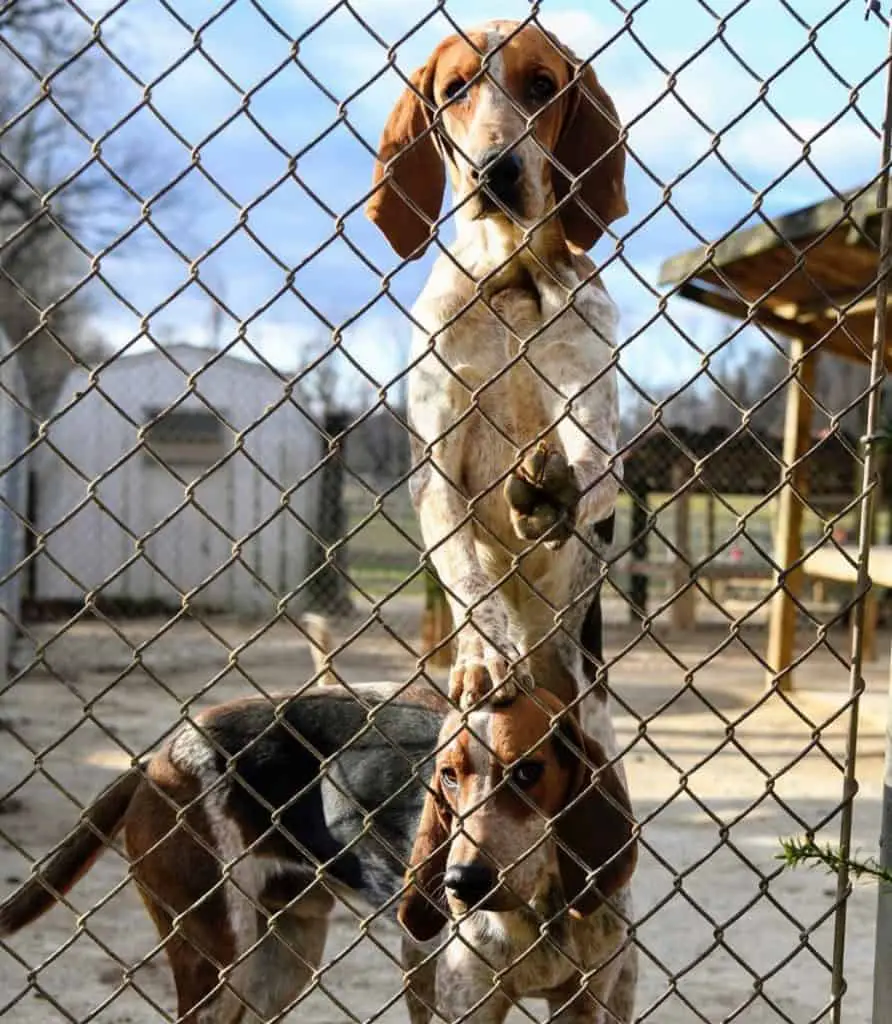
Containing a high flying dog can be a difficult prospect. Owners must make considerations for how high a dog can jump when choosing a pet containment system. Low fences could result in a dog that escapes and puts itself in danger or otherwise ruffles the neighbors.
So how high can a foxhound jump? Any foxhound owner will tell you that a
foxhound can easily jump nearly six feet straight up! These dogs are middleweight
jumping champs – they are literally built for the high jump.
Foxhounds have incredible drive, stamina, determination, intelligence, and a
near-legendary stubborn streak when they set their minds to accomplish
something.
These exact traits are what make foxhounds such superlative hunt and trail
dogs, but they can get them in trouble in the companion canine lifestyle.
Foxhounds need a solid one to two hours per day of exercise, minimum, to avoid
a turn towards destructive behaviors.
In this context, jumping can become one of those destructive behaviors, since a
bored or lonely foxhound is going to take matters into their own hands and find
something to do.
Read on to learn for other considerations to factor in before adding this dog breed to your family.
Foxhound Breed Background:
The American Foxhound isn’t one of the best-known companion canine breeds outside of their home state of Virginia, where this breed has been the official state dog since 1966.
But in Virginia, the American Foxhound has a fascinating and storied history that dates back to the time of the American Revolution!
The American Foxhound is distantly related to the English Foxhound, according to The American Kennel Club (AKC) but has longer legs and a finer bone structure.
Both breeds have what the AKC terms “melodious” voices – hounds, of course, mostly howl and bay instead of barking (although they bark as well). An American Foxhound can make a great family pet provided you are willing to make some special accommodations for this dog’s athleticism and exercise needs.
Considerations When Getting a Foxhound Fence
We can only recommend the foxhound as a companion canine if an appropriate protective and escape-proof is in place. Let’s talk for a moment about what “escape-proof” means in context with a foxhound.
Foxhounds have been known to climb up chain-link fencing to heights of six feet or greater. Some foxhounds have managed to climb all the way to the top of a six-foot chain-link fence and jump down the other side. They are incredibly agile and have thin paws that can easily use the chain-link segments as footholds.
This is incredibly dangerous for the foxhound! Your dog break bones and tear muscles and ligaments scaling and jumping fences. Since foxhounds have such an intense need and drive to run and scent, an escaped foxhound could be difficult to locate.
Fencing for a foxhound needs to meet these criteria, at minimum, in order to provide protection against breed-specific instincts that your dog will not be able to control:
- At least six foot high fence.
- Fence topper that extends out horizontally inward (in case your dog makes it all the way to the top).
- Solid wood, vinyl or other smooth material with zero potential footholds.
- Fencing extends at least a foot beneath the soil surface to prevent digging.
- Very sturdy and solid material.
- Gate with a secure lock that is mounted high and is certified canine-proof.
Pet Fence Options for Dogs that Jump
The best pet fence options for dogs like foxhounds that absolutely will jump and try to escape your back yard will always be solid-sided fences.
Hardwood, vinyl, very fine mesh wire, aluminum, PVC or bamboo (sustainable wood) fencing are all solid choices to keep your foxhound inside the fence.
Always steer clear of chain link, wrought iron or any fencing material that might offer clear footholds for an enterprising foxhound. Even if your dog loves life with you and has no desire to actually escape, these intelligent hounds can’t resist a challenge – so be sure not to give your dog one!
Other Pet Containment Systems for Dogs that Jump
Foxhounds really need to run and exercise and jump and stretch their legs every single day.
You don’t want to choose a foxhound dog unless you are sure you either have time every single day to take your dog for a long run or, alternately, that you can offer your dog a large piece of escape-proof property on which to run.
There are several ways to provide pet containment that is protective without being overly restrictive. After all, the inability to exercise and move is going to be as damaging to your foxhound as escaping and not being able to find their way home.
Here are some creative ideas that really work that we have heard about from other foxhound owners:
- Build a second fence, or a “fence within a fence” (yes, this really does mean one fence inside another fence).
- Plant a row of solid bushes or trees in front of your fence (make sure the trees grow at least 8 feet high in maturity).
- Install an L-footer. An L-footer is an L-shaped topper that functions like a lip to keep your dog from ever gaining a foothold if they reach the top of the fence, however high.
- Install a coyote roller. A coyote roller’s original purpose was to keep enterprising coyotes from jumping or climbing a fence from the outside in and gaining access to your yard. But it can be equally effective when installed to prevent your foxhound from climbing out!
- Install cat netting. Cat netting is a lot like L-footers and coyote rollers, just a different mechanism to prevent escape.
- Avoid fences all together and take your pup out on a leash for frequent exercise.
Foxhounds as Family Pets
The American Kennel Club (AKC) uses adjectives like “sweet-tempered,” “easygoing,” “good-natured” and “low-maintenance” to describe American Foxhounds as a breed.
However, there is a vital subtext to the choice of these words, and it holds true for any dog breed, not just foxhounds or even hounds.
Your foxhound will only fit in well with your family and community if their basic needs are met in full each and every day. With a foxhound, this means exercise and lots of it. You will need to be sure that someone in your family will be available every single day for one to two hours to take your dog for long walks or (ideally) runs.
A healthy, mature foxhound can easily run for hours at a time without tiring, just as this breed would naturally do when out on a hunt. This is just part of the deliberate breeding that has fashioned these dogs into such expert trail and hunting dogs.
This is also why you must make absolutely certain that your foxhound will not be able to escape your control at any time, because their urge to run is so strong you won’t be able to catch your dog and they likely will not find their way back home.
As long as your foxhound is well-exercised to the point of natural fatigue each day, you can expect your new pup to get along well with family members of all ages and even other pets, including cats.
If you currently have other small vulnerable pets in your family, however, it is wise to rethink choosing a foxhound. These dogs have such as strong prey drive there is a very real risk of your other pets coming to harm.
Is Barking a Concern with Foxhounds?
Canine breeds that do not bark are few and far between. Having said that, however, we must emphasize that foxhounds in particular and hound breeds, as a rule, will favor tuneful howling and baying over barking.
Hounds can also be somewhat nocturnal with their vocalizing. This arises from the practice of taking dogs on evening hunts when their primary prey is more likely to be up and stirring.
If you have never kept company with a hound previously, keep in mind that foxhounds, like all hounds, have excellent vocal projection. Their voices have literally been bred to carry for miles. This is a great asset when scenting and hunting ahead or retrieving prey at a distance from their human hunting partners.
It isn’t such a great asset when your neighbors are trying to get some much-needed shut-eye. A resonant, vocalizing, night owl foxhound is likely not going to endear you to the neighborhood so it is best to make arrangements to house your foxhound indoors each night.
Are Foxhounds Good with Kids?
According to Vetstreet, the American Foxhound is particularly good and gentle with small children and can be surprisingly patient even with roughhouse play.
Foxhounds can also be quite tolerant of cats and other dogs, especially if they are raised together.
Foxhounds generally range in weight from 60 to 70 pounds in adulthood, with females weighing on average five pounds less than males. Even though foxhounds as a rule are slim, fine-boned dogs, it is always smart to supervise time between a dog this size and babies or very small children just to be sure no accidental harm arises.
Do Foxhounds Shed A Lot?
Foxhounds have a very short, dense, double-layer coat. The coat usually doesn’t exceed two inches in length and has a coarse, water-resistant outer layer with a finer, soft, insulating under layer.
Foxhounds do shed moderately year-round and more so at the changing of the seasons once or twice annually. But their coat is “wash and wear” – and in fact, in our experience, it usually isn’t necessary to bathe a foxhound unless they roll in something they find while out for a run.
You can easily get by with a good brushing once or twice per week just to control shed hair and get the circulation going in your dog’s skin.
American foxhounds can make great family pets. They are naturally protective of the whole family (including kids and cats) and can exist happily as a single dog or with other dogs to play with.
Foxhounds, like all dogs, have certain breed-specific characteristics to remain aware of. As long as you can meet a foxhound’s daily needs for exercise and install escape-proof protective fencing, you can look forward to many years of joy together.
